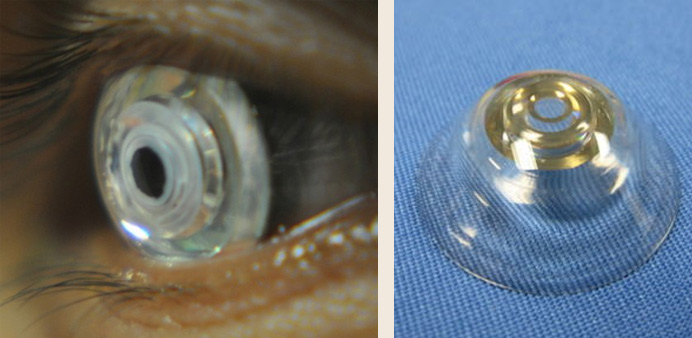AFP/San Jose
Swiss researchers are developing contact lenses that contain tiny telescopes to boost vision and zoom in and out with the wink of an eye, researchers said.
The latest advances in vision aids -- some of which could potentially help the 285 million people worldwide with some form of vision impairment -- were discussed at the American Association for the Advancement of Science annual meeting in California.
The contact contains an extremely thin, reflective telescope, which is activated by winks and embedded inside a 1.55 millimeter-thick lens.
First released in 2013 and fine-tuned since then, the prototype was unveiled by Eric Tremblay from the Ecole Polytechnique Federale de Lausanne in Switzerland.
The lenses come with smart glasses that respond to the wearer's winks -- but not blinks -- so that the user can switch almost effortlessly from normal to magnified vision and back.
The wearer blinks with the right eye to activate the telescope, and with the left eye to deactivate it.
"We think these lenses hold a lot of promise for low vision and age-related macular degeneration," a vision disorder that affects older people, Tremblay said.
"At this point this is still research, but we are hopeful it will eventually become a real option for people with AMD."
The device magnifies objects 2.8 times, meaning AMD patients can read more easily and recognize faces and objects.
Funded by the Defence Advanced Research Projects Agency (DARPA), the lenses were meant to serve as a form of bionic vision for soldiers.
"Small mirrors within bounce light around, expanding the perceived size of objects and magnifying the view, so it's like looking through low magnification binoculars," the researchers said in a statement.
- 'Huge leap' -
Tremblay was careful to stress that the device was still at the research stage, though it could eventually become a "real option" for people with AMD.
"It's very important and hard to strike a balance between function and the social costs of wearing any kind of bulky visual device," he said.
"There is a strong need for something more integrated, and a contact lens is an attractive direction."
Several precision-cut pieces of plastic, aluminium mirrors and polarizing thin films form the lens, along with biologically safe glues.
Because the eye needs a steady supply of oxygen, the scientists have worked on making the device more breathable, using tiny air channels that are approximately 0.1 millimetres wide within the lens.
Daniel Palanker of Stanford University said researchers have so far been able to restore visual acuity to half the normal level in blind rats.
The research team, which includes the University of California, San Diego as well as experts at Paragon Vision Sciences, Innovega, Pacific Sciences and Engineering, and Rockwell Collins, described their product as "a huge leap" forward, compared to glasses already on the market for people with AMD that have mounted telescopes but tend to be bulky and awkward to use.
Unlike the older models, which require the user to tilt his or her head and position the eyes just right in order to use them, the latest products can actually track eye movement, making them easier to use.


